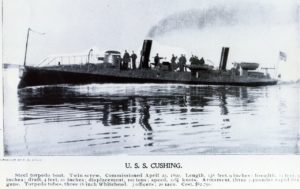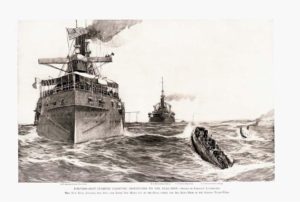June 1, 2018
Curator’s Log September 2018
The Herreshoff-built CUSHING and Destruction of the MAINE

The Herreshoff-built CUSHING and Destruction of the MAINE
One hundred and twenty years ago on 15 February 1898 the battleship MAINE blew up in Havana harbor. At the museum we know the story well because we have been relating to years of visitors how the US Navy's first sea-going torpedo boat, the Herreshoff designed and built, USS CUSHING (TB-1) raced from Havana to Key West, Florida to cable the news to authorities in Washington DC. A stirring story; crossing the one hundred miles of the Florida Strait at better than 22 knots to deliver the message of destruction and heavy loss of life- electrifying the nation to declare war on Spain. Trouble is the story is not true- it did not happen that way- on the night in question CUSHING was safely and quietly moored in Key West.
For the best description of CUSHING's part in the events of that time we refer to the memoir of Admiral Albert Gleaves USN, then a Lieutenant and commanding officer of CUSHINGfrom May 1897 to September 1898.1
Gleaves first assignment in CUSHING was to the Torpedo Station in Newport, stopping enroute to transport Assistant Secretary of the of the Navy Theodore Roosevelt from his home on Oyster Bay Long Island to speak at the Naval War College. Gleaves had almost no torpedo experience save some work in spar torpedo equipped launches carried on cruisers and battleships. That changed dramatically with CUSHING setting a record of launching over 400 self-propelled torpedoes during the summer of 1897.2
The 137-foot, 105 tons displacement CUSHING (Figure I- CUSHING as configured in 1897-8) was manned with one other officer, Ensign Cabell Breckinridge, serving as executive officer, and an enlisted crew of 22. Living quarters were cramped, Gleaves describing the officers cabin as a "cubbyhole".3
In September 1897 and war with Spain over Cuba threatening the just delivered Herreshoff PORTER (TB-6), and DUPONT (TB-7)-176-foot, 165 tons; together with the Iowa Iron Works built ERICSSON (TB-2)-150-foot, 120 tons; joined CUSHING at the direction of Theodore Roosevelt to form the US Navy's first torpedo flotilla and fit out for war. Starting south for Key West in late September they followed a route explored by CUSHING in Spring 1895, using inside passages wherever possible. Among the coast guardsmen and lighthouse tenders they met, one lifeboat man visiting the deck of CUSHING was recorded to have said, "I'd just as leave go to sea on a whale." (CUSHING being smaller and lower in the water than the other boats.) They arrived in Key West on New Year's Eve and were joined by the Atlantic Fleet a few days later.4
In January 1898 as MAINE departed for Havana, her commanding officer Captain Sigsbee passed special Navy Department instructions to Gleaves designating him by name to maintain daily contact by cable with either MAINE or the US resident Consul General in Havana, Fitzhugh Lee. He was to report any urgent happenings or interruption of cable service to the fleet commander at the Dry Tortugas and the department.5, 6
On 10 February CUSHING was ordered to leave the next morning to join MAINE in Havana harbor. The plan was for CUSHING to remain for several days, tied up alongside MAINE. The passage across the Florida Straits faced a blowing "half a gale against the Gulf Stream current, making a heavy sea". (Figure II- CUSHING in heavy seas and strong winds) Shortly after noon Breckinridge started aft from the conning tower in rain coat & high rubber boots when CUSHING took a "deep violent roll to starboard" throwing him against the copper lifelines that snapped and into the water. It required 20 minutes of frantic effort to recover his lifeless body.7
The tragedy cut short CUSHING's stay in Havana. Before departing on the morning of 13 February, just 63 hours before the explosion, Gleaves discussed the possibility of an attack on the MAINE with her executive officer. He was confident and unconcerned stating, "Our guns command every fort in the harbor, and they could not bring a single one two bear on us." There was no talk of mines.8
Upon returning to Key West Gleaves resumed the exchange of daily messages with Fitzhugh Lee. At 10 PM on 15 February a naval officer controlling secret agents in Havana informed Gleaves of a report that the MAINE had blown up. Rushing to the cable office they awaited confirmation from Havana, which came from Captain Sigsbee reporting the MAINE blew up at 9:40 PM; the Spanish were providing assistance; and that "Public opinion should be suspended until further report." The next day survivors arrived at Key West with an amplifying report from Sigsbee, to be coded and sent to the Secretary of the Navy; "MAINE was probably destroyed by a mine. It may have been done by accident. I surmise that the berth was one planted previous to her arrival, perhaps long ago. I can only surmise this."9
The Atlantic Fleet immediately mobilized for war. CUSHING received a new executive officer and participated in nightly defensive torpedo boat patrols off Key West. The 21 March 1898 report of the court of inquiry found MAINE had blown up from outside but did not fix responsibility. "In its opinion the ship was destroyed by the explosion of a submarine mine, which caused the partial explosion of two or more of the forward magazines". This led directly to a Congressional joint resolution authorizing military intervention, followed by a declaration of war; all under the banner "Remember the Maine"; and all within one month of the board's report.10
MAINE's Destruction Postscript
From the very beginning there were doubts about the cause of the explosion. In 1911 the Corps of Engineers and the navy's Board of Inspection and Survey, examined the wreck in detail taking a large number of photos. But again, they concluded an explosive exterior to the ship had ignited the ship's magazines.11
In 1975 Admiral Hyman Rickover, Father of the Nuclear Navy, assembled a team of experts who on their own time examined all the records reaching a finding that the explosion was an accident due to an internal cause. These conclusions were revisited and reconfirmed in 1995 and 1997. Quoting from his 1995 book, How the Battleship Maine Was Destroyed, the Admiralcautioned;
"The MAINEshould impress us that technical problems must be examined by competent and qualified people, and that the results of their investigation must be fully and fairly presented to their fellow citizens."12
John Palmieri


1 Gleaves, Albert, The Admiral: The Memoirs of Albert Gleaves, Admiral, USN. Hope Publishing, Pasadena, CA. 1985
2 Gleaves, p. 83-4. See also Curator's Log July 2017, "Herreshoff and US Naval Torpedo Station Newport: Developing the Torpedo Boat as a Weapon" chronicling the extensive torpedo test activities involving Herreshoff's CUSHING and STILETTO.
3 Ibid, p. 83
4 Ibid, p. 84-5
5 Ibid, p. 86
6 MAINE's visit to Havana was unannounced in advance but reported as "friendly". Hansen, I. S. & Wegner, D. M., "Centenary of the Destruction of USS Maine". Naval Engineers Journal. ASNE March 1998.p. 93.
7 Gleaves, p. 86-7, 90
8 Ibid, p. 87
9 Ibid, p. 88-9. Gleaves also received a note of condolence from the captain of a Spanish gunboat that he forwarded to the Secretary believing it to be a strong indication that Spanish naval officers had nothing to do with the explosion.
10 Ibid, p. 91 CUSHING's new executive officer fell through the main hatch, fracturing some ribs and delaying CUSHING's participation in the war off Cuba. p. 92
11 Hansen & Wegner, p. 98
12 Ibid, p. 103
